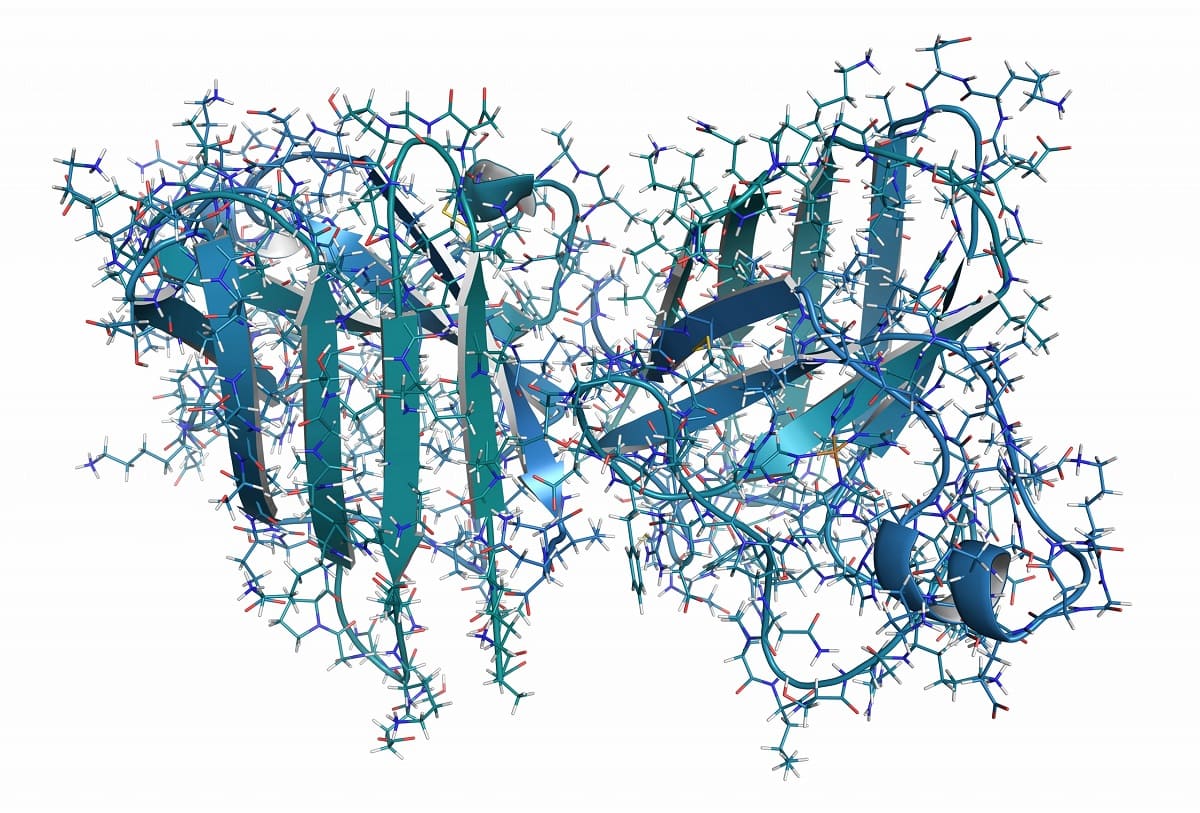Home>Science & Environment>Enzyme Denaturation At High Temperatures: Causes And Effects


Science & Environment
Enzyme Denaturation At High Temperatures: Causes And Effects
Published: February 19, 2024
Learn about the causes and effects of enzyme denaturation at high temperatures in this comprehensive guide. Explore the impact on the environment and scientific advancements.
(Many of the links in this article redirect to a specific reviewed product. Your purchase of these products through affiliate links helps to generate commission for Temperatures.com, at no extra cost. Learn more)
Table of Contents
Introduction
Enzymes are remarkable biological molecules that play a pivotal role in various biochemical reactions within living organisms. These catalysts are essential for sustaining life, as they facilitate the conversion of substrates into products at a remarkable pace. Enzymes are highly specific, meaning each enzyme is designed to catalyze a particular reaction, ensuring the smooth functioning of cellular processes.
The activity and stability of enzymes are influenced by a myriad of factors, including temperature. Enzymes exhibit optimal activity within a specific temperature range, beyond which their structure and function can be compromised. This phenomenon, known as enzyme denaturation, occurs when enzymes are exposed to high temperatures, leading to a loss of their three-dimensional structure and, consequently, their catalytic activity.
Understanding the causes and effects of enzyme denaturation at high temperatures is crucial in various fields, including biochemistry, biotechnology, and food science. Moreover, exploring methods to prevent enzyme denaturation can pave the way for the development of novel strategies to enhance the stability and functionality of enzymes in diverse applications.
In this article, we will delve into the intricate world of enzymes, shedding light on their structure, the causes and effects of denaturation at high temperatures, and effective methods to mitigate this phenomenon. By unraveling the complexities of enzyme denaturation, we aim to underscore the significance of preserving enzyme functionality and the potential implications for various scientific and industrial endeavors.
The Structure of Enzymes
Enzymes are intricate macromolecular structures that exhibit a highly specific and complex three-dimensional architecture. Their structural composition is fundamental to their catalytic activity and specificity. Enzymes are predominantly composed of proteins, although some RNA molecules also possess catalytic properties and are classified as ribozymes.
The primary structure of an enzyme refers to the linear sequence of amino acids that constitute its polypeptide chain. This sequence is encoded by the gene that governs the synthesis of the enzyme. The unique arrangement of amino acids in the polypeptide chain forms the basis for the subsequent levels of structural organization.
The secondary structure of enzymes arises from the folding of the polypeptide chain into alpha helices, beta sheets, and other recurring structural motifs. These secondary structures are stabilized by hydrogen bonds between the peptide bonds of the amino acids.
Tertiary structure encompasses the three-dimensional conformation of the enzyme, resulting from the intricate folding and bending of the polypeptide chain. This level of organization is crucial for the formation of the enzyme's active site, where the catalytic activity occurs. The active site is a region within the enzyme that binds to the substrate, facilitating the biochemical reaction.
Quaternary structure is relevant for enzymes composed of multiple polypeptide chains. In such cases, the individual chains assemble to form a functional enzyme complex. The arrangement of these subunits contributes to the overall structure and function of the enzyme.
The structural integrity of enzymes is paramount for their functionality. Any alteration in the three-dimensional structure, such as that induced by high temperatures, can lead to the denaturation of the enzyme, resulting in a loss of catalytic activity. Understanding the intricate structure of enzymes provides valuable insights into their susceptibility to denaturation and the subsequent effects on their functionality.
Enzymes are marvels of nature, finely tuned to perform specific biochemical tasks with remarkable efficiency. Their structural complexity underpins their catalytic prowess, making them indispensable players in the intricate web of biological processes. By unraveling the intricacies of enzyme structure, scientists can gain deeper insights into the mechanisms governing enzyme denaturation and explore innovative strategies to preserve their functionality in diverse applications.
Causes of Enzyme Denaturation at High Temperatures
Enzyme denaturation at high temperatures is a complex phenomenon influenced by various factors that disrupt the intricate three-dimensional structure of enzymes. Understanding the causes of this process is crucial for elucidating the underlying mechanisms and devising strategies to mitigate its effects.
-
Disruption of Hydrogen Bonds: High temperatures can lead to the disruption of hydrogen bonds, which are vital for maintaining the secondary and tertiary structures of enzymes. These bonds play a pivotal role in stabilizing the folding patterns of the polypeptide chains, and their disruption can result in the loss of the enzyme's functional conformation.
-
Increased Molecular Motion: Elevated temperatures augment the kinetic energy of molecules, including enzymes, leading to increased molecular motion. This heightened motion can destabilize the intricate folding of the enzyme, ultimately compromising its structural integrity and catalytic activity.
-
Alteration of Hydrophobic Interactions: Enzyme stability is also reliant on hydrophobic interactions, which contribute to the folding and stabilization of the enzyme's tertiary structure. High temperatures can disrupt these interactions, leading to the exposure of hydrophobic regions that are typically sequestered within the enzyme's core. This exposure can trigger unfolding and denaturation.
-
Impact on Ionic Interactions: Ionic interactions, such as salt bridges, are crucial for maintaining the stability of an enzyme's structure. High temperatures can disrupt these interactions, leading to the destabilization of the enzyme's three-dimensional conformation and subsequent denaturation.
-
Influence on Covalent Bonds: While covalent bonds contribute to the overall stability of an enzyme, extreme temperatures can lead to the cleavage of these bonds, resulting in the irreversible denaturation of the enzyme.
-
Effect on Cofactors and Prosthetic Groups: Enzymes often require cofactors or prosthetic groups for their catalytic activity. High temperatures can disrupt the binding of these essential components, thereby compromising the enzyme's functionality.
The causes of enzyme denaturation at high temperatures are multifaceted, involving intricate molecular interactions that are sensitive to thermal fluctuations. By comprehensively understanding these causes, scientists can explore innovative approaches to mitigate the effects of high temperatures on enzyme stability, thereby enhancing the applicability of enzymes in various industrial and scientific domains.
Effects of Enzyme Denaturation at High Temperatures
The denaturation of enzymes at high temperatures can have profound effects on their functionality and the biochemical processes they facilitate. Understanding these effects is crucial for comprehending the repercussions of enzyme denaturation and its implications in various scientific and industrial contexts.
-
Loss of Catalytic Activity: Enzyme denaturation at high temperatures often leads to a significant reduction or complete loss of catalytic activity. The alteration in the enzyme's three-dimensional structure disrupts the active site, rendering it incapable of effectively binding to the substrate and catalyzing the biochemical reaction. This loss of catalytic activity can impede crucial metabolic processes and biochemical transformations, impacting the overall functionality of biological systems.
-
Reduced Specificity: Enzymes exhibit remarkable specificity in their interactions with substrates, ensuring that the correct biochemical reactions occur with precision. However, denaturation at high temperatures can compromise this specificity, leading to altered substrate binding and reduced efficiency in catalyzing specific reactions. The loss of specificity can result in the accumulation of undesired by-products and hinder the normal progression of metabolic pathways.
-
Diminished Stability: Enzyme denaturation can diminish the stability of the enzyme, making it more susceptible to further degradation and inactivation. The compromised structural integrity resulting from denaturation renders the enzyme vulnerable to proteolytic degradation and other destabilizing factors, further exacerbating its functional impairment.
-
Altered Regulatory Functions: Some enzymes serve regulatory roles in biochemical pathways, modulating the rates of specific reactions to maintain metabolic homeostasis. Denaturation at high temperatures can disrupt these regulatory functions, leading to dysregulated metabolic pathways and potential imbalances in cellular processes.
-
Impact on Industrial Applications: In industrial settings, enzyme denaturation at high temperatures can significantly impact processes such as food processing, biofuel production, and pharmaceutical manufacturing. The loss of enzymatic activity due to denaturation can hinder the efficiency of these processes, leading to decreased product yields and increased operational costs.
-
Biotechnological Implications: Enzymes are widely utilized in biotechnological applications, including the production of bio-based products and the development of biocatalysts. The denaturation of enzymes at high temperatures can impede these applications, necessitating the exploration of novel strategies to enhance enzyme stability and functionality under thermal stress.
Understanding the effects of enzyme denaturation at high temperatures underscores the critical need to develop approaches that mitigate these effects and preserve the functionality of enzymes in diverse applications. By unraveling the repercussions of denaturation, scientists can pave the way for innovative solutions to enhance the stability and resilience of enzymes in the face of thermal challenges.
Methods to Prevent Enzyme Denaturation at High Temperatures
Preserving the functionality of enzymes in high-temperature environments is a critical endeavor with far-reaching implications in various scientific, industrial, and biotechnological domains. To mitigate the detrimental effects of enzyme denaturation at elevated temperatures, several innovative methods have been developed to enhance enzyme stability and resilience. These methods encompass a diverse array of strategies aimed at preserving the structural integrity and catalytic activity of enzymes under thermal stress.
1. Protein Engineering:
Protein engineering techniques, such as site-directed mutagenesis and rational design, enable the modification of enzyme structures to enhance their thermal stability. By introducing specific amino acid substitutions or optimizing the enzyme's active site, protein engineers can confer greater resistance to denaturation at high temperatures.
2. Immobilization:
Immobilizing enzymes onto solid supports or within matrices can shield them from the detrimental effects of high temperatures. Immobilization techniques not only enhance the stability of enzymes but also facilitate their reusability, making them invaluable in various industrial processes.
3. Stabilizing Additives:
The incorporation of stabilizing additives, such as osmolytes, polyols, and specific ions, can bolster the stability of enzymes at high temperatures. These additives interact with the enzyme's structure, mitigating the disruptive effects of thermal stress and preserving its catalytic activity.
4. Encapsulation:
Encapsulating enzymes within protective microenvironments or nanocarriers shields them from the harsh conditions of high temperatures. This approach not only safeguards the enzyme from denaturation but also enables precise control over its microenvironment, further enhancing its stability.
Read more: Enzymes: Reusability And Benefits
5. Directed Evolution:
Directed evolution methodologies, such as DNA shuffling and error-prone PCR, enable the generation of enzyme variants with enhanced thermal stability. By subjecting enzymes to iterative rounds of mutagenesis and selection under high-temperature conditions, researchers can evolve enzymes with superior resistance to denaturation.
6. Rational Formulation:
Developing rational formulations that optimize the composition of enzyme solutions or reaction mixtures can mitigate the effects of high temperatures. By carefully selecting buffer systems, cosolvents, and other formulation components, scientists can enhance the thermal resilience of enzymes in diverse applications.
7. Structural Characterization:
Utilizing advanced structural characterization techniques, such as X-ray crystallography and nuclear magnetic resonance (NMR) spectroscopy, provides valuable insights into the structural determinants of enzyme stability. This knowledge can inform the rational design of enzymes with enhanced resistance to denaturation.
8. Computational Modeling:
Employing computational modeling and molecular dynamics simulations enables the prediction of enzyme stability under high-temperature conditions. These simulations facilitate the identification of critical regions within the enzyme structure that are susceptible to denaturation, guiding targeted strategies for enhancing thermal resilience.
By harnessing these innovative methods, scientists and engineers can advance the frontiers of enzyme stability and functionality, paving the way for the development of robust biocatalysts and biotechnological solutions that thrive in high-temperature environments. These strategies not only hold immense potential for enhancing industrial processes but also underscore the remarkable adaptability of enzymes in the face of thermal challenges.
Conclusion
In conclusion, the intricate world of enzymes and their susceptibility to denaturation at high temperatures unveils a captivating narrative of molecular resilience and scientific ingenuity. The structural intricacies of enzymes, governed by the precise arrangement of amino acids and the delicate interplay of secondary, tertiary, and quaternary structures, underscore the remarkable adaptability of these biological catalysts. However, when exposed to high temperatures, enzymes face a formidable challenge as thermal stress disrupts the delicate balance of molecular interactions that sustain their functionality.
The causes of enzyme denaturation at high temperatures, ranging from the disruption of hydrogen bonds and hydrophobic interactions to the impact on ionic and covalent bonds, paint a vivid portrait of the molecular intricacies that underpin enzyme stability. These multifaceted interactions, sensitive to thermal fluctuations, underscore the complex interplay of forces that dictate the fate of enzymes in thermal environments.
Furthermore, the effects of enzyme denaturation at high temperatures, encompassing the loss of catalytic activity, reduced specificity, and diminished stability, highlight the far-reaching implications of thermal stress on enzyme functionality. These effects reverberate across diverse scientific, industrial, and biotechnological domains, underscoring the critical need to develop innovative strategies to preserve the resilience and catalytic prowess of enzymes in high-temperature environments.
The methods to prevent enzyme denaturation at high temperatures, ranging from protein engineering and immobilization to directed evolution and rational formulation, exemplify the remarkable strides made in enhancing enzyme stability and functionality. These innovative approaches, rooted in the principles of molecular engineering and biophysical insights, herald a new era of enzyme resilience, offering promising avenues for the development of robust biocatalysts and biotechnological solutions that thrive in thermal challenges.
In essence, the journey through the complexities of enzyme denaturation at high temperatures unveils a tapestry of scientific exploration and technological innovation. By unraveling the intricacies of enzyme structure, understanding the causes and effects of denaturation, and harnessing innovative methods to mitigate thermal stress, scientists and engineers stand at the forefront of a transformative era in enzyme resilience. This journey not only holds immense potential for advancing industrial processes and biotechnological applications but also underscores the remarkable adaptability of enzymes in the face of thermal challenges, paving the way for a future where enzymes thrive in the heat of scientific and industrial pursuits.












